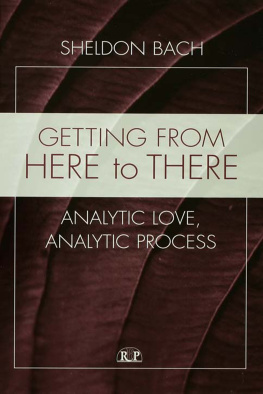Sheldon Bach - Getting From Here to There: Analytic Love, Analytic Process
Here you can read online Sheldon Bach - Getting From Here to There: Analytic Love, Analytic Process full text of the book (entire story) in english for free. Download pdf and epub, get meaning, cover and reviews about this ebook. year: 2006, publisher: Routledge, genre: Religion. Description of the work, (preface) as well as reviews are available. Best literature library LitArk.com created for fans of good reading and offers a wide selection of genres:
Romance novel
Science fiction
Adventure
Detective
Science
History
Home and family
Prose
Art
Politics
Computer
Non-fiction
Religion
Business
Children
Humor
Choose a favorite category and find really read worthwhile books. Enjoy immersion in the world of imagination, feel the emotions of the characters or learn something new for yourself, make an fascinating discovery.
- Book:Getting From Here to There: Analytic Love, Analytic Process
- Author:
- Publisher:Routledge
- Genre:
- Year:2006
- Rating:5 / 5
- Favourites:Add to favourites
- Your mark:
Getting From Here to There: Analytic Love, Analytic Process: summary, description and annotation
We offer to read an annotation, description, summary or preface (depends on what the author of the book "Getting From Here to There: Analytic Love, Analytic Process" wrote himself). If you haven't found the necessary information about the book — write in the comments, we will try to find it.
It is clinical work with the most difficult patients - those with severe narcissistic, sadomasochistic, and borderline disorders - that poses the greatest challenge to the therapists guiding assumptions about clinical process; indeed, such work often leads therapists to question beliefs and expectations that formerly seemed self-evident. In Getting From Here to There: Analytic Love, Analytic Process, Sheldon Bach elaborates the holistic vision that guides him in work with just such patients. He dwells especially on the attentive presence through which the analyst effects a meeting with patients that invites the latters trust in the analyst and in the therapeutic process. And he writes of love - of patient for analyst and of analyst for patient - that grows out of this mutual trust and sustains therapeutic process. For Bach, analytic therapy aims at understanding the person as a mind-body unity that manifests particular states of consciousness.
This holistic vision of treatment sustains a flexible clinical orientation that enables the analyst to meet states of consciousness in order to bring them into a system of which the analyst forms a part. Bach thoughtfully explores the clinical issues that enter into this taxing process, among them the establishment and maintenence of basic trust; the patients or the therapists presence in the others mind; and the shifts in agency between patient and therapist. And he describes at length the frequently exhausting, even demoralizing, transference-countertransference struggles that enter into this type of analytic work.
Throughout, Bach is guided by the conviction that work with extremely challenging patients promotes the psychological growth and increased self-knowledge of patient and analyst alike. And he is admirably clear that the mutual living through of such treatments nurtures a kind of love between patient and analyst.
Getting From Here to There not only records the clinical lessons learned by an unusually gifted analyst; it also chronicles the movement of psychoanalysis itself from the dissection of love into component parts to a synthetic grasp of its vital role in psychoanalytically informed treatment.
Sheldon Bach: author's other books
Who wrote Getting From Here to There: Analytic Love, Analytic Process? Find out the surname, the name of the author of the book and a list of all author's works by series.













